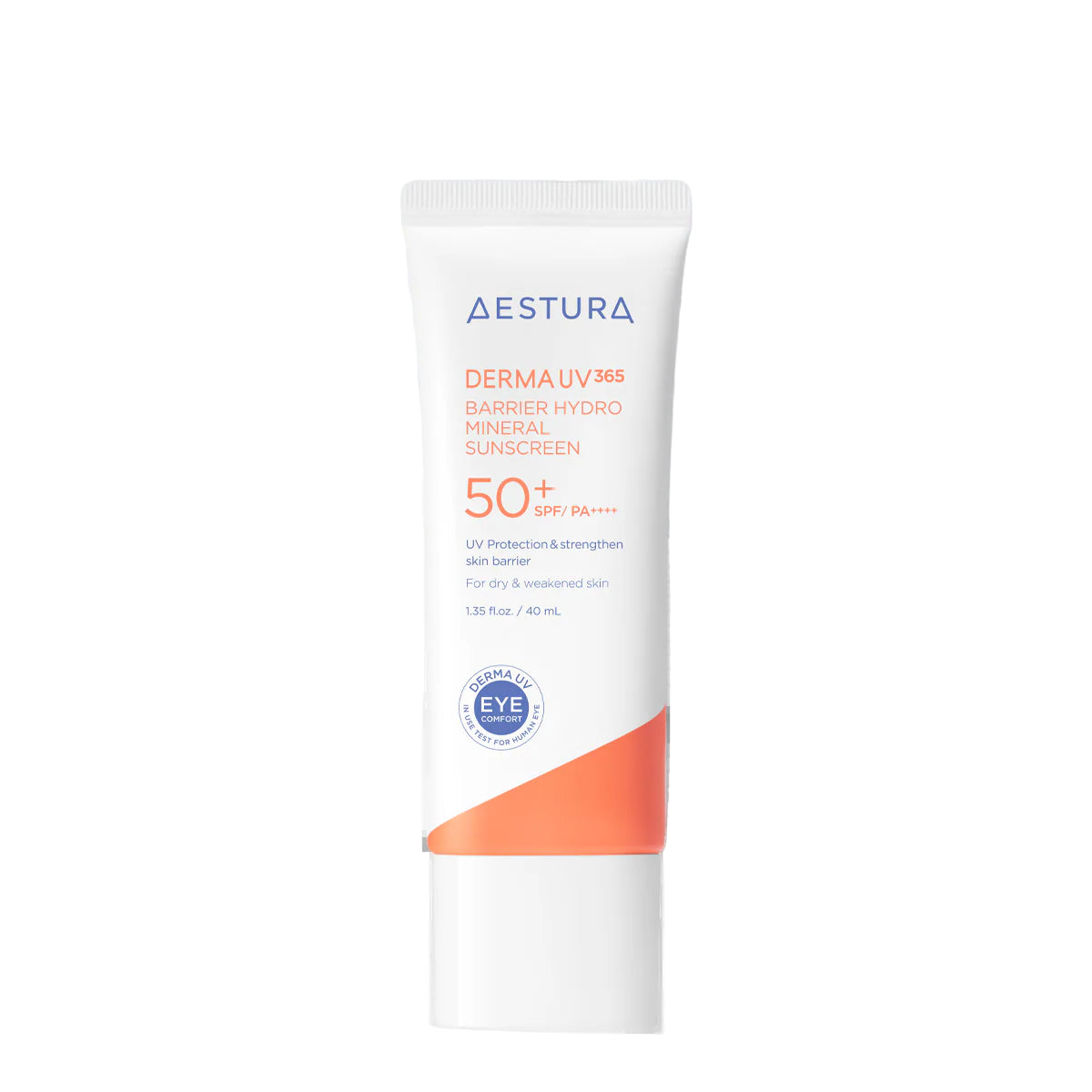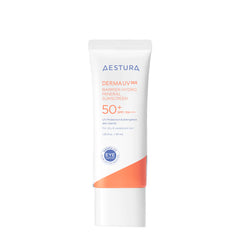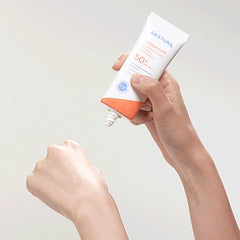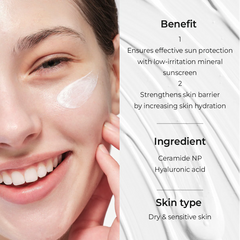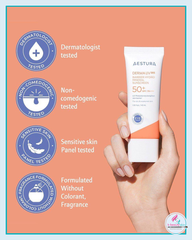Description
xThe Aestura Derma UV365 Barrier Hydro Mineral Sunscreen is a mineral (physical) sunscreen developed with a focus not only on broad‑spectrum UV protection but also on skin barrier reinforcement and moisture support. Its formula is designed especially for dry, sensitive, or barrier‑compromised skin types. The “365” in the name suggests everyday, year‑round use; “Barrier Hydro” indicates its aim to hydrate and support the skin barrier while “Mineral” signals its physical (rather than chemical) filtering mechanism.
Because the 20 ml mini size is a smaller quantity of the same core formula, it offers a travel‑friendly or trial alternative for those who want to test the product before committing to a full size. All the functional benefits—UV protection, barrier repair, hydration, gentle profile—are presumed to carry over to the 20 ml version.
Key Features & Benefits
Here are the standout features and benefits of this sunscreen, particularly in relation to its target skin types and use cases:
1. Broad‑Spectrum Mineral UV Protection
This sunscreen uses zinc oxide (nano) as its primary UV filter. As a mineral filter, zinc oxide provides physical blocking of UV radiation (reflecting and scattering) rather than absorption. It is generally considered lower irritation risk compared to many chemical filters.
The listed sun protection metrics are SPF 50+ (guarding against UVB) and PA++++ (very high UVA protection).
2. Barrier Reinforcement & Moisture Boost
What sets this sunscreen apart is its dual function: in addition to protecting skin from UV damage, it aims to strengthen and restore the skin barrier. Aestura uses a Barrier Moisture Ceramide™ concept with Ceramide NP built into the formula, intended to help reconstitute barrier lipids and reduce water loss.
Moreover, multiple forms of hyaluronic acid (sodium hyaluronate, acetylated hyaluronate, hydrolyzed hyaluronic acid) are included to provide multi‑level hydration—some molecules targeting surface layers, others aiming for deeper penetration.
Clinical data presented by the brand claims the following after a single application:
-
+71 % improvement in skin barrier strength L
-
+316 % increase in skin moisture
These figures are based on controlled trials with 30 adult subjects.
3. Gentle, Low‑Irritation Profile
Recognizing that people with sensitive or reactive skin may struggle with typical sunscreens, Aestura emphasizes low irritation, ophthalmological safety, and dermatological testing:
-
It is claimed to produce low eye irritation, verified via human eye irritation tests.
-
It is dermatologically tested (patch tests), sensitive skin panel tested, and ophthalmologist tested for eye safety.
-
The formula is fragrance‑free, free of animal‑origin ingredients, free of talc, polyacrylamides, PEG, imidazolidinyl urea, triethanolamine, and tar colorants.
-
It is marketed as non‑chemical (i.e. purely mineral), which for some users is perceived as milder on sensitive skin.
4. Lightweight, Refreshing Texture & Finish
Though many mineral sunscreens tend to be heavy or leave a chalky white cast, Aestura’s formula is designed for more comfortable wear:
-
The texture is described as “refreshing” and moisturizing, leaving a matte surface finish while hydrating deeper layers.
-
The product claims to “absorb deeply” while still leaving the superficial feel matte and not greasy.
-
It is engineered to spread easily like a lotion, reducing risk of clumping or uneven film. If applied evenly and softly patted, it is claimed to avoid white cast.
5. Soothing & Calming Ingredients
To complement its protective role, Aestura adds allantoin as a soothing agent to relieve irritation and calm the skin.
Furthermore, tocopherol (vitamin E) is present as an antioxidant, helping protect against UV‑induced oxidative stress.
These additions support the idea that this sunscreen is not just a barrier against rays, but also an active skincare product that nurtures skin comfort.
Ingredient & Mechanism Insights
Delving a bit deeper into how the formula works:
-
Zinc Oxide (nano): The main UV filter. As a mineral filter, it is considered stable under sunlight and less likely to cause chemical irritation. However, nano‑sized particles are used to reduce whiteness on the skin.
-
Cyclohexasiloxane, Disiloxane, Isododecane: Volatile silicones or emollients used to enhance spreadability and help the formula glide over skin, leaving a smooth, lightweight feel.
-
Propanediol: A humectant/solvent that helps hydrate skin and carry other ingredients.
-
Butyloctyl Salicylate, Propylheptyl Caprylate: Emollients that help with solubilizing mineral filters and improving the sensory feel (less tacky or chalky).
-
Disteardimonium Hectorite, Magnesium Sulfate: Rheology modifiers and stabilizers, keeping the dispersion of minerals uniform and preventing settling.
-
Triethoxycaprylylsilane: A silane often used to coat pigments or mineral particles (e.g. zinc oxide) to improve dispersibility and reduce powderiness.
-
Sodium Hyaluronate, Acetylated Hyaluronate, Hydrolyzed Hyaluronic Acid: Layers of hyaluronic acid work synergistically to hydrate across different depths. The acetylated form may offer better surface retention, and the hydrolyzed form penetrates more easily.
-
Ceramide NP: A skin‑identical lipid that helps rebuild the barrier lipid matrix, reducing transepidermal water loss and improving resilience.
-
Allantoin: Helps soothe and reduce irritation, often used to minimize stinging or redness.
-
Tocopherol (Vitamin E): Acts as an antioxidant to mitigate free radical stress induced by UV exposure.
The combination of humectants, barrier lipids, emollients, stabilizers, and mineral filters is engineered to maintain a stable, skin‑friendly, protective, and comfortable sunscreen.
Usage & Application (20 ml Mini)
Because the mini is smaller, the usage and technique are the same as the full size. Here’s how to use it properly to get the full benefits:
-
Final Step of Morning Skincare
Use this sunscreen as the last step in your morning skincare routine: after cleanser, toner, serum, moisturizer. It should layer over hydrators and creams (if any). -
Amount & Coverage
Apply an adequate amount to all sun‑exposed areas—face, neck, ears. For best protection, the amount should be generous enough to form a uniform, even film. Because it is a mineral sunscreen, underapplication may lead to insufficient UV coverage. -
Even Spread & Patting
Spread the product gently and evenly, then pat lightly to encourage absorption without disrupting the layer. Because the formula is designed to behave like a lotion, good spreading minimizes white cast or patchiness. -
Reapplication
Reapply every 2 hours when outdoors, after sweating or swimming, to maintain effective protection. -
Around Eyes
The formula is claimed to produce low eye irritation, but still apply cautiously near the eye area, gently patting rather than rubbing. -
Patch Test & Sensitivity
Even for a gentle sunscreen, it’s wise to patch test (e.g. behind the ear or inner arm) for 24–48 hours before full use, especially if your skin is reactive or acne‑prone. -
Storage & Handling
Keep the cap sealed, prevent contamination, and avoid extreme heat or direct sunlight. Use the mini within a recommended timeframe after opening (often 6–12 months, depending on packaging, although the brand does not clearly state shelf life in online descriptions).
Suitability & User Experience
Skin Types & Conditions
-
Dry / Sensitive / Barrier‑Compromised Skin
This is the core target. The inclusion of ceramide and multiple hyaluronic acids means that this sunscreen aims to protect without drying, soothe while blocking UV, and help fortify a fragile barrier. -
Normal / Combination Skin
Many with combination skin may find the texture comfortable—light enough for less oily zones, but with enough nourishment for dryer patches. -
Oily / Acne‑Prone Skin
Mineral sunscreens are often better tolerated by acne‑prone skin, given lower propensity for irritation. However, certain emollients or silicones might cause mild clogging in very reactive skin, so monitoring is necessary. -
Reactive / Post‑Procedure / Post-Inflammatory Skin
Because of its gentle profile and barrier‑supporting ingredients, it could be suitable for skin in recovery (e.g. after laser, peel, retinoid usage), assuming careful patch testing and professional guidance.
Reported User Feedback & Limitations
While many enjoy its benefits, some reported downsides and caveats in user reviews and forums:
-
Breakouts / Irritation
A few users report that they experienced pimples or skin irritation after using it. One user with combination skin observed “tiny pimples” and inflamed blemishes after about a week. -
Oiliness / Greasy Feel
Some users in hot or humid climates find the formula feels greasy or causes increased oiliness, especially on the T-zone or forehead. -
White Cast Concerns
As with many mineral sunscreens, there is potential for white cast if not applied carefully. In some experiences, users mention noticeable white cast under certain lighting or makeup. -
Availability or Discontinuation Worries
Some users speculate that it might be getting harder to find or discontinued, though it is still listed on official pages.
Because individual skin tolerance and environmental conditions vary widely, these reports underscore the importance of trial and careful observation.
Pros & Cons Summary
Pros:
-
Broad‑spectrum SPF 50+ / PA++++ protection using a mineral filter (zinc oxide)
-
Barrier support via ceramide NP and diverse hyaluronic acid derivatives
-
Gentle, low irritation, and ophthalmologically tested
-
Lightweight, smooth texture designed to reduce chalkiness and avoid white cast
-
Added soothing (allantoin) and antioxidant (tocopherol) benefits
-
Fragrance-free and free of many harsh additives
Cons / potential drawbacks:
-
Like many mineral sunscreens, risk of white cast if applied unevenly
-
Some users may experience breakouts or irritation, particularly if skin is sensitive or clogged
-
In hot or humid climates, may feel greasy or heavy in some zones
-
The mini size (20 ml) may run out fast if used generously or frequently reapply
-
The brand's claimed percentages (e.g. 71% barrier improvement) should be viewed with caution—these are based on limited brand‑sponsored trials
Suggested Positioning for the 20 ml Mini Version
When writing product copy or marketing material for the 20 ml mini, you can highlight:
-
Trial / travel size that allows users to test compatibility before purchasing full size
-
Retains all the core formula features (UV protection, barrier care, hydration) in a compact package
-
Ideal for users who want to carry sunscreen on the go (e.g. handbag, gym bag, commuting)
-
A less wasteful commitment for those concerned about shelf life or formula changes
Even in the mini, communicate the same application instructions, patch test recommendation, reapplication needs, and gentle claims.
Example Narrative Description (Condensed)
This is an illustrative way you might present the product to customers (still detailed):
Introducing the Aestura Derma UV365 Barrier Hydro Mineral Sunscreen (20 ml mini)—a high‑performance, dermatologist-designed mineral sunscreen that doesn’t just block UV rays but actively cares for your skin barrier. Powered by Zinc Oxide (nano) for safe, broad-spectrum protection (SPF 50+ / PA++++), this formula incorporates Barrier Moisture Ceramide™, delivering Ceramide NP alongside multiple forms of hyaluronic acid to hydrate, reinforce, and restore even the most sensitive or dry skin.
Designed for everyday wear, it spreads effortlessly like a lotion, leaving a refreshing, matte finish without leaving greasy residue or chalkiness. Its gentle, fragrance‑free profile is ophthalmologist-tested for minimal eye irritation, making it a reliable choice even near delicate eye zones. Crafted for both protection and skin health, it includes allantoin to soothe potential irritation and vitamin E (tocopherol) for antioxidant support.
Clinical testing reveals a 71% improvement in barrier strength and 316% boost in moisture after a single application (30-person trial). As a 20 ml mini, it’s perfect for trying out the formula or keeping your skin protected on the move. Apply it as the final step in your morning routine, reapply every two hours when outdoors, and pat gently for even coverage.
Whether you have dry, sensitive, or reactive skin—or simply want a sunscreen that does more than just block rays—this mineral formula is designed to shield, nourish, and support your skin all year long
Related Products
- Choosing a selection results in a full page refresh.





